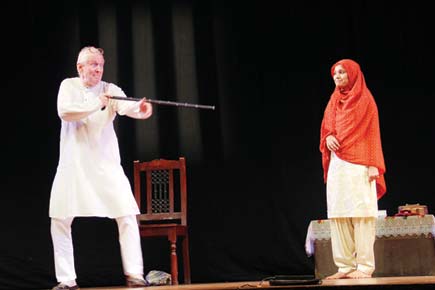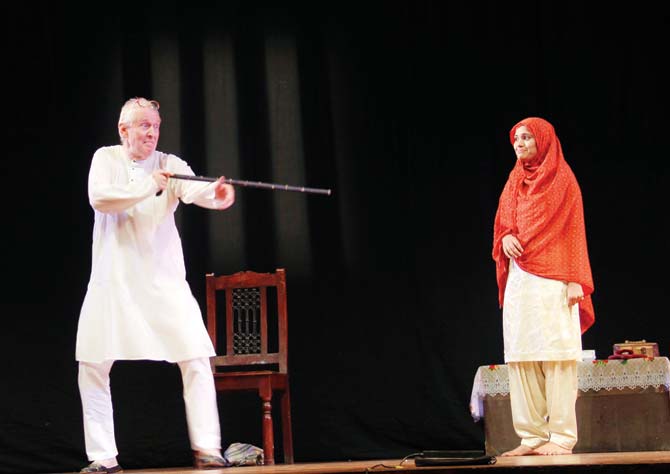Celebrating theatre pioneer Begum Qudsia Zaidi, who revived classics for a contemporary audience

 Around this time last year, celebrations for Begum Qudsia Zaidi’s birth centenary commenced, with productions of her plays, an exhibition of photographs, a seminar and talks in Delhi and Mumbai. The year wound down with a warm tribute by admirers and friends of the family at Chaupaal. Begum Zaidi’s daughter is Shama Zaidi, her son-in-law is MS Sathyu, one of her granddaughters, Shaili, is a theatre practitioner specialising in plays for children, the other, Seema, is an artist — both worked on researching and gathering material for a wonderful tribute to their remarkable grandmother.
Around this time last year, celebrations for Begum Qudsia Zaidi’s birth centenary commenced, with productions of her plays, an exhibition of photographs, a seminar and talks in Delhi and Mumbai. The year wound down with a warm tribute by admirers and friends of the family at Chaupaal. Begum Zaidi’s daughter is Shama Zaidi, her son-in-law is MS Sathyu, one of her granddaughters, Shaili, is a theatre practitioner specialising in plays for children, the other, Seema, is an artist — both worked on researching and gathering material for a wonderful tribute to their remarkable grandmother.

Tom Alter plays the eponymous protagonist in Chacha Chakkan ke Karname, the rebooted version of a popular children’s play by Begum Qudsia Zaidi
ADVERTISEMENT
Begum Qudsia Zaidi was a theatre pioneer and established a group called Hindustani Theatre in Delhi in 1955. Some of the finest theatre productions in India have been from her writings — classic plays that she adapted into Hindustani so beautifully that they often surpassed the originals. The list is enviable — Mitti Ki Gaadi, Shakuntala, Aazra Ka Khwab (Pygmalion), Anarkali, Amrapali, Mudrarakshas, Khalid Ki Khala (Charlie’s Aunt), Vasantsena, Sufaid Kundali, (The Caucasian Chalk Circle), Mera Naam Trufaldin (Servant of Two Masters), Gudiya Ghar (Doll’s House).
According to information collected for the centenary celebrations, Begum Zaidi wrote and translated a number of books for children, and was actively involved in Shankar’s Weekly Children’s Art Competitions and Book Trust. Chacha Chakkan ke Draamae, is one of her most popular series of plays for children.
To quote from the text, “When she moved to Delhi, Qudsia also developed a keen interest in theatre through her close association with Kamladevi Chattopadhyay, one of India’s cultural doyens. Qudsia began to build an artistic and intellectual circle around her, her charm and wit regularly attracting poets, writers, and painters to the Zaidi home in Jamia. She became a member of numerous cultural bodies, contributing to the cultural foundations of post-Independence Delhi and India. In 1954, she met Habib Tanvir, who is today remembered as the founder of Naya Theatre. Together, they established the Hindustani Theatre.” Interestingly, Tanvir met his wife Monica while working with Hindustani Theatre; MS Sathyu and Shama Zaidi also met there. “There were other romances too,” says Shaili Sathyu, “but they have been forgotten.”
Tanvir’s classic Agra Bazaar was produced then, after which he went to study at RADA. While waiting for him to return, Begum Zaidi wrote several plays, so that the group would have a ready repertoire, and also raised money from her well-connected sources — Begum Pataudi was one of the trustees — including Pandit Nehru, who granted an annual fund.
“The Hindustani Theatre,” says a note on the company, “began as a concerted effort to produce and sustain a regular, serious art theatre that was at once professional and wedded to the roots of traditional Indian art forms. A visionary committed to the theatre traditions of India, yet intensely contemporary, Begum Zaidi imagined a theatre that stood upon classical, national heritage, while also consistently considering its own relevance. Think of England without Marlowe and Shakespeare, France without Moliere, Spain without Lope de Vegas and Calderon. For Begum Zaidi, it was imperative that the rich wealth of Sanskrit classical plays be laid bare to the contemporary audience in popular yet literary idiom, in operatic and dance forms that were the aesthetic foundations of traditional plays.”
“The Hindustani Theatre, with this theatrical daring, would eventually become Delhi’s first post-Independence professional theatre troupe. The movement began to grow in 1957 (two years after the Hindustani Theatre was established) with an active group of talented artists and seasoned directors. The theatre itself took on an organic form, directing and producing a few plays until it incrementally created a composite form of theatre that reconfigured India’s cultural traditions. For the first time, urban thespians began working with folk actors to produce poetic forms of theatre for contemporary audiences. Begum Zaidi, in her characteristic boldness, became convinced that theatre, to be a living force, must be manned by full-time artists. Instead of loans, grants and donations, Begum Zaidi wanted the theatre to become independent and self-supporting. On August 1, 1960, the Hindustani Theatre was made a full-fledged, full-time theatre,” the note adds.
On November 14 — Children’s Day — Shakuntala opened to a huge audience in Bhilai, as part of a tour of steel plants. During this tour, actors earned their salaries by their own work as performers. During this triumphant tour, Begum Zaidi passed away on December 27, 1960, when she was just 46.
As it usually happens, when an organisation has a strong, visionary driving force, it tends to crumble and collapse when the leader passes away. After a few years of trying to keep Hindustani Theatre alive as a cooperative, the members scattered.
However, when three actresses — Salima Raza, Preeta Mathur and Lubna Salim — perform extracts from Aazar Ka Khwab, as the sharp-tongued spitfire Hajjo who is transformed into a lady, it is clear just how valuable Begum Qudsia Zaidi’s legacy is, and that there are people who admired her work and will keep the flame burning.
Deepa Gahlot is an award-winning film and theatre critic and an arts administrator. She tweets at @deepagahlot
 Subscribe today by clicking the link and stay updated with the latest news!" Click here!
Subscribe today by clicking the link and stay updated with the latest news!" Click here!







